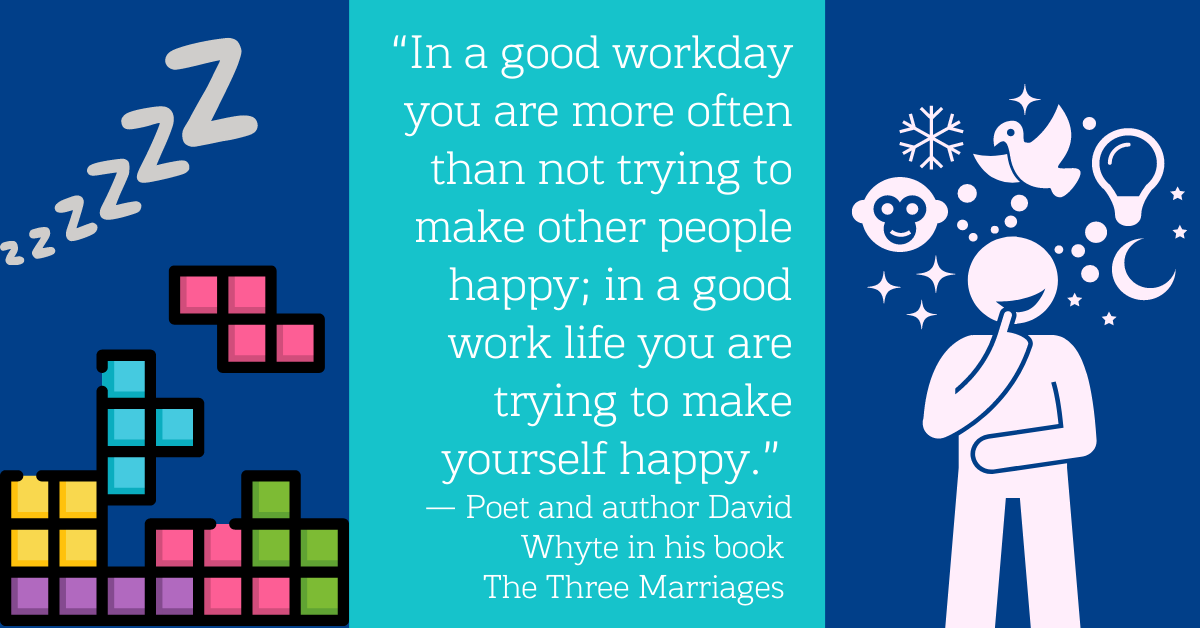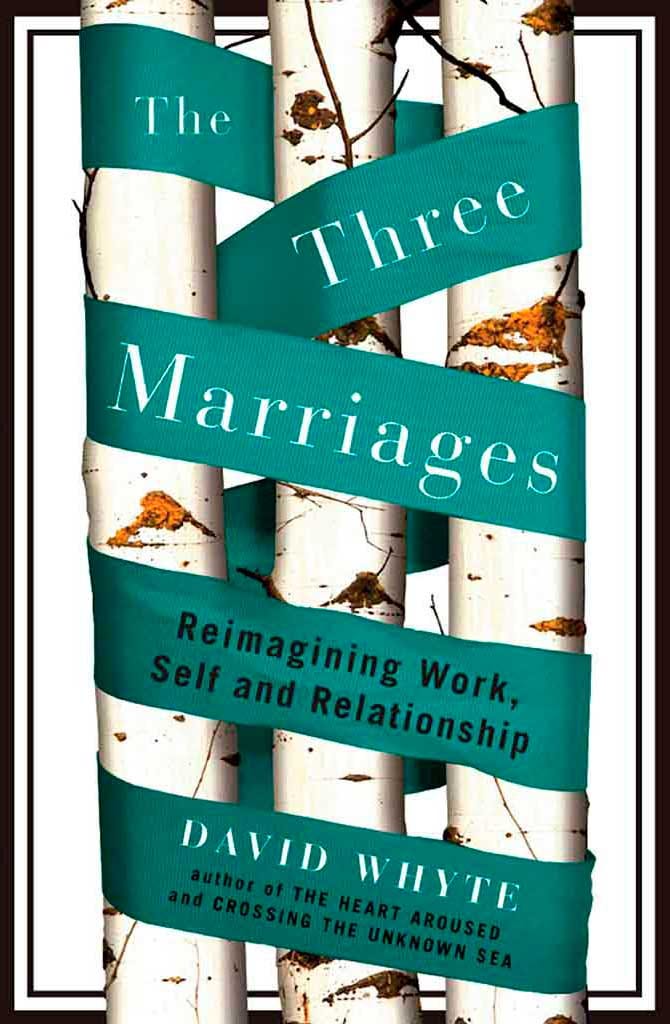Field Notes #16
Visionary Jane McGonigal on how imagining a detailed future scenario shifts your mind forever, Tetris as a sleep aid, and David Whyte on our work marriage
Hello, dear friends. You may have noticed that there was no Odyssey newsletter these past two Sundays. Whew! It’s a wildly busy season here at work. I’m softening my Sunday writing for a little while until our conference and gala season passes. I imagine you all understand this disconcerting undulation of creativity and time. How do you adjust? What do you do when life speeds up? What do you hang onto, and what drops off?
Thanks for understanding and for being with me on this journey.
Now, on to the Field Notes…
1} Playing games to fall asleep
This set of sleep suggestions from futurist, researcher, and author Jane McGonigal was so counter-intuitive to me that I had to share it with you. I try to turn off my phone and computer well before bed, partly because of the overwhelming advice that screen light inhibits slumber. (I don’t always succeed in this attempt — see tonight, ha!)
But now see Jane’s two recommendations for when you have trouble falling asleep, because your mind is whirling around:
One uses video games, and one uses the future. So the video game one, pretty easy. Video games allow us to control our thoughts and imagination, right? They focus our attention on a problem that isn’t real, right? It’s a game, and we can be swapping candy tiles, or catching Pokémon, or whatever we’re doing in the game, and it allows us to shut down the busy thoughts, the hyper mental stimulation, and it does seem to be pretty effective as a bedtime routine. The only side effect is that you might dream or hallucinate about the game when you fall asleep, so you might see those Tetris blocks falling when you close your eyes, but that’s not too bad a side effect. It’s better than Ambien, I think.
The studied “dose” around video games in health research is generally 10 minutes, she says.
Side note: Jane personally likes to play Quordle, which is FOUR (!) Wordles at once. (What? Yes. It’s awesome!)
(For those of you who have been wondering, What is this Wordle thing I keep hearing about? It’s a word game in which you guess a mystery 5-letter word. You start by guessing any 5-letter real word. The letters that are actually in the mystery word turn either green or yellow. Green means the letter is in the right spot. Yellow means the letter is in the mystery word, but in a different spot. Gray means the letter isn’t in the mystery word at all. You get 6 tries. It’s fun!)
1} Imagining the future
So what’s Jane’s second recommendation to help shift your busy brain when you can’t fall asleep?
Imagining the future.
Jane is big on imagining the future. She has set up alternate reality spaces in which thousands of people have imagined, in specific, vivid detail, what a certain kind of future might be like. In 2010, she set up a scenario in which nearly 20,000 people were told to imagine it being 10 years in the future and a new respiratory virus was spreading across the world, schools had shut down, masks were recommended, quarantine orders were given. What was it like? What did you do? What did you say to who?
Jane explains in this interview:
The number one thing [imagining the future] accomplishes is that it obliterates normalcy bias. Once you have vividly imagined a future, it is literally imaginable and you will no longer deny the possibility. You will not underestimate the risk. You will spot evidence of change faster. This is why my book is called Imaginable, because we want to be able to imagine the world, either that we might wake up in, or that we create through our own actions that is better than a world today.
... Any of the scenarios that listeners have heard in this episode, they can just go do this now. Literally pull out a notepad. I find it works better when you write by hand because you don’t want to edit or censor yourself, so we recommend free writing. You set a timer for five minutes and just write for five minutes, whatever comes to mind with as many details as you can.
Pick one of these scenarios, future of sex, future of deep fakes, future of whatever we were talking about, drone, art and storytelling, whatever you want and just write a journal entry from this future. It will literally change your brain forever. That future is now forever imaginable to you, and it only took five minutes.
After the novel coronavirus emerged around the world in 2020, Jane heard from people who had been in her 2010 study. They told her that they felt like they picked up the signs of the pandemic earlier, that they were less shocked, less scared, more prepared than their friends and family who had never seriously contemplated this possibility.
I’m wondering now if imagining all sorts of future scenarios could be helpful for people with chronic illnesses. Would it be helpful? Or terrifying? Would it make us more prepared? Or more worried? If I ever get a chance to interview Jane (see: dreams of podcasts and Q&As), I’ll ask. Hmm.
The entire podcast interview with Jane McGonigal on the Tim Ferriss Show is fascinating, packed with interesting tidbits that will shift your mind about how you think about the future. Jane is a future forecaster and world-renowned designer of alternate reality games that improve real lives and solve real problems. She’s also the creator of Urgent Optimists, an online community that is like a book club for futurists, imagining a future scenario together each month. She is the author of several books now on my reading list, including Imaginable: How to See the Future Coming and Feel Ready for Anything―Even Things That Seem Impossible Today, which came out this spring.
3} Work: The Second Marriage
Finally, I know I’m not alone in this frenzied period of work. Teachers and professors are wrapping up the semester. Students are studying for their final exams. Doctors and nurses are feeling the exodus of their colleagues and the continual weight of the pandemic. No doubt there are a hundred occupations dealing with their own particular spikes of activity.
For leveling thoughts about work, I turn to David Whyte, a poet, writer, speaker, who delves with uncanny observations and gentle guidance into how we live, how we work, how we love. In his wonderful book The Three Marriages: Reimagining Work, Self and Relationship, he probes what he calls the three marriages: the first marriage (“the one we usually mean”) to a person, the second marriage to work, and the third marriage to our own self. How do we navigate our hopes, our expectations, our days, our lives with these three epic commitments?
David observes:
“Happiness in the second marriage of work, like happiness in the first marriage with a person, is possible only through seeing it in a greater context than surviving the everyday. We must have a relationship with our work that is larger than any individual job description we are given. A real work, like a real person, grows and changes and surprises us, asking us constantly for recommitment. In work, we have often made secret vows; sometimes we do not know ourselves what those vows are until we look back with some perspective on the actual nature of the work we have accomplished.”
And this bit to ponder:
“In a good workday you are more often than not trying to make other people happy; in a good work life you are trying to make yourself happy.”
I hope you have a lovely week, full of good work, great rest, and perhaps even a Quordle or two.
To our journeys and healthier days ahead,
Brianne
p.s. A note about Field Notes #15 — I’ve removed the paragraph about the Wirecutter smoke alarm recommendation because that model isn’t representative of any of the types in the study mentioned. Many thanks to researcher Dr. Gary Smith for pointing this out.





